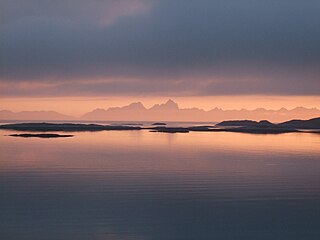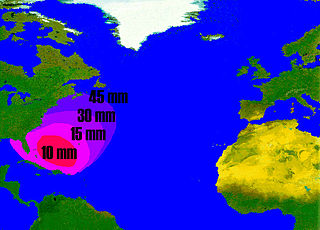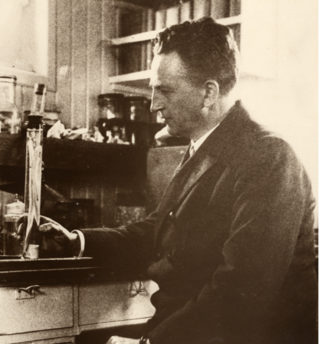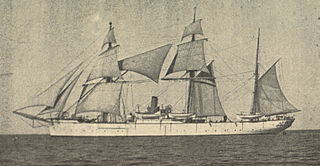
The Atlantic Ocean is the second-largest of the world's five oceans, with an area of about 85,133,000 km2 (32,870,000 sq mi). It covers approximately 17% of Earth's surface and about 24% of its water surface area. It is known to separate the "Old World" of Africa, Europe, and Asia from the "New World" of the Americas in the European perception of the World.

The Norwegian Sea is a marginal sea, grouped with either the Atlantic Ocean or the Arctic Ocean, northwest of Norway between the North Sea and the Greenland Sea, adjoining the Barents Sea to the northeast. In the southwest, it is separated from the Atlantic Ocean by a submarine ridge running between Iceland and the Faroe Islands. To the north, the Jan Mayen Ridge separates it from the Greenland Sea.
The Cod Wars were a series of 20th-century confrontations between the United Kingdom and Iceland about fishing rights in the North Atlantic. Each of the disputes ended with an Icelandic victory.

The European eel is a species of eel. They are critically endangered due to overfishing by fisheries on coasts for human consumption and parasites.

Eels are any of several long, thin, bony fishes of the order Anguilliformes. They have a catadromous life cycle, that is: at different stages of development migrating between inland waterways and the deep ocean. Because fishermen never caught anything they recognized as young eels, the life cycle of the eel was a mystery for a very long period of scientific history that continues into the present day. Of significant interest is the search for the spawning grounds for the various species of eels and identifying impacts to population decline in each stage of the life cycle.

The haddock is a saltwater ray-finned fish from the family Gadidae, the true cods. It is the only species in the monotypic genus Melanogrammus. It is found in the North Atlantic Ocean and associated seas, where it is an important species for fisheries, especially in northern Europe, where it is marketed fresh, frozen and smoked; smoked varieties include the Finnan haddie and the Arbroath smokie.

USS Bear was a dual steam-powered and sailing ship built with six-inch (15.2 cm)-thick sides which had a long life in various cold-water and ice-filled environments. She was a forerunner of modern icebreakers and had a diverse service life. According to the United States Coast Guard official website, Bear is described as "probably the most famous ship in the history of the Coast Guard."

USCGC Northwind (WAG/WAGB-282) was a Wind-class icebreaker, the second United States Coast Guard Cutter of her class to bear the name. She was built to replace USCGC Staten Island which was in Soviet lend-lease service.

The research ship had origins in the early voyages of exploration. By the time of James Cook's Endeavour, the essentials of what today we would call a research ship are clearly apparent. In 1766, the Royal Society hired Cook to travel to the Pacific Ocean to observe and record the transit of Venus across the Sun. The Endeavour was a sturdy boat, well designed and equipped for the ordeals she would face, and fitted out with facilities for her research personnel, Joseph Banks. And, as is common with contemporary research vessels, Endeavour carried out more than one kind of research, including comprehensive hydrographic survey work.

Ernst Johannes Schmidt was a Danish biologist credited with discovering in 1920 that European eels migrate to the Sargasso Sea to spawn. Before this people in North America and Europe had wondered where the small glass eels, or elvers, came from.

The European conger is a species of conger of the family Congridae. It is the heaviest eel in the world and native to the northeast Atlantic, including the Mediterranean Sea.

USCGC Yamacraw (WARC-333) was a United States Coast Guard Cable Repair Ship. The ship was built for the Army Mine Planter Service as U. S. Army Mine Planter Maj. Gen. Arthur Murray (MP-9) delivered December 1942. On 2 January 1945 the ship was acquired by the Navy, converted to an Auxiliary Minelayer and commissioned USS Trapper (ACM-9) on 15 March 1945. Trapper was headed to the Pacific when Japan surrendered. After work in Japanese waters the ship headed for San Francisco arriving there 2 May 1946 for transfer to the Coast Guard.

Pourquoi-Pas was the fourth ship built for Jean-Baptiste Charcot, which completed the second Charcot expedition of the Antarctic regions from 1908 to 1910. Charcot died aboard when the ship was wrecked on 16 September 1936, off the coast of Iceland. Of the forty men on board, only one survived.

The first USS Patuxent was a fleet tug in commission in the United States Navy from 1909 to 1924. She served the United States Atlantic Fleet and saw service in World War I. After the end of her Navy career, she was in commission in the United States Bureau of Fisheries from 1926 to 1932 as the fisheries research ship USFS Albatross II.

USS Rockaway (AVP-29), later AG-123, was a United States Navy Barnegat-class seaplane tender in commission from 1943 to 1946. She served in both the Atlantic Ocean and the Pacific Ocean during World War II. In 1948, she was loaned to the United States Coast Guard, in which she served as the cutter USCGC Rockaway (WAVP-377), later WAGO-377, WHEC-377, and WOLE-377, from 1949 to 1972.

The Shenandoah is a three-masted schooner with a steel hull, built in New York in 1902 as a private yacht for the American financier Gibson Fahnestock. She has had a series of private owners since, and is available today for charter.

Dana was a four-masted motor schooner built for the Danish East Asiatic Company (EAK) and launched in 1919. It was made available to the Danish marine biologist Johannes Schmidt, who used it for two expeditions to the Sargasso Sea in 1920–1921. The main goal of the expeditions, named the first and second Dana expeditions, was searching for the spawning grounds of the European eel.
The Dana expeditions were four Danish research expeditions from 1920 to 1930. The first two were undertaken by the Dana I and the third by the Dana II. They were funded in part by the Carlsberg Foundation and led by Johannes Schmidt. The first three expeditions took place from 1920 to 1922 and the fourth and final was from 1928 to 1930. They centered around investigating the breeding of eels. The first two expeditions allowed Schmidt to prove his theory that European eels migrate to the Sargasso Sea to spawn. The final expedition traveled to the Indian Ocean and gathered numerous samples.

HDMS Ingolf was a Danish schooner-rigged steam gunboat build in iron and launched in 1876. Ingolf marks a transition between the traditional gunships with muzzle-loading cannons placed along the sides of the ship and modern breechloading and turning guns placed in the centerline of the ship. The guns on Ingolf were breechloading guns from Krupp in Germany. The steam engine was British and could deliver 650 HP. The propeller could be hoisted up into a well on the underside of the ship, so as not to slow down the ship when she went for sails. Ingolf undertook a large number of voyages, often in the North Atlantic in summer and the Danish West Indies in winter. From 1897 Ingolf also served as training ship for non-commissioned officers and cadets. During World War I Ingolf was part of the Danish alerted fleet. The last voyage as a training ship was in 1922 and went to the Mediterranean. Decommissioned in 1926 and sold for scrap.

ICGV Þór was the first patrol ship of the Icelandic Coast Guard. It was named after the nordic mythology god Þór. She was built by Edwards Brothers at North Shields, England in 1899 as a steam trawler for Danish-Icelandic trade and fishing association in Geirseyri and later served as a research ship for Denmark. In 1920, Björgunarfélag Vestmannaeyja bought the ship for use in fishing control and rescue work. After paying for its operational cost for several years, the Icelandic government decided to buy the ship in 1926. With its purchase, the Icelandic Coast Guard was de facto established. In the early years, the ship was armed with two 57 mm cannons, which were later replaced by one 47 mm cannon. Þór ran aground at Húnaflói during a storm on 21 December 1929. As a result, it was decided to buy a new patrol vessel in its place.




















